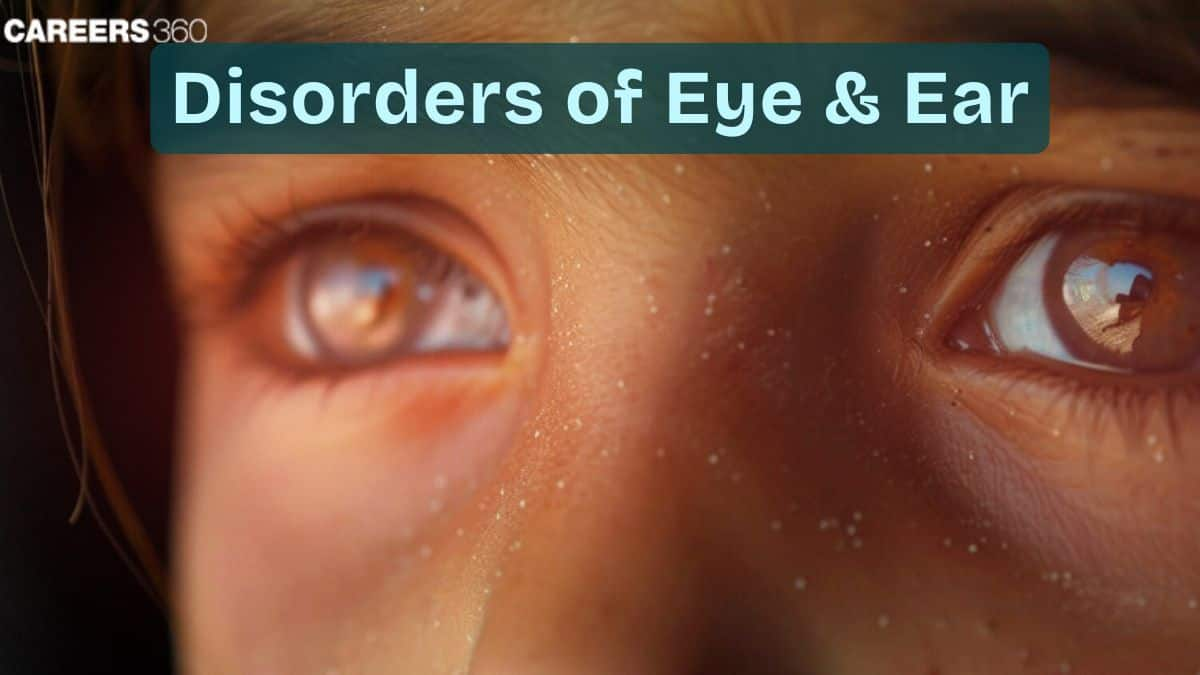Disorders of Eye and Ear: Symptoms, Cause, Treatment
Disorders of the eye and ear affect two essential senses—vision and hearing—and can significantly reduce quality of life. Eye disorders range from refractive errors to optic nerve damage, while ear disorders affect hearing or balance. This guide covers definitions, major disorders, causes, symptoms, treatments, diagrams, NEET notes, and MCQs.
This Story also Contains
- Introduction — Why Eye & Ear Disorders Matter
- Common Eye Disorders
- Common Ear Disorders
- Disorders of Eye & Ear NEET MCQs (With Answers & Explanations)
- Recommended video on "Disorders of Eye and Ear"

Introduction — Why Eye & Ear Disorders Matter
The eye and ear disorders are very debilitating as they affect vision and hearing, which reflects in the quality of life. The said disorders are studied to diagnose and treat sensory impairments.
Common Eye Disorders
The eye disorders may range from minor problems to grave ones affecting visions.
Myopia(Nearsightedness)
It is a condition wherein distant objects appear dim.
Hyperopia (Farsightedness)
It is a state where near objects appear dim.
Cataract
The lens becomes cloudy, and blurred vision ensues.
Glaucoma
An increased pressure inside the eyeball, due to malfunctioning of the drainage mechanisms, finally leads to damage to the optic nerve.
Common Ear Disorders
The disorders of the ear affect either hearing or balance.
Otitis Media
Infection mainly causes infection in the middle ear.
Tinnitus
A whining or buzzing in one's ear.
Hearing Loss
Partial deafness or total deafness.
Meniere's Disease
A disorder in the inner structure of the ear in which a patient experiences vertigo associated with deafness.
Disorders of Eye & Ear NEET MCQs (With Answers & Explanations)
Important questions asked in NEET from this topic are:
Structure of the human eye and ear
Disorders of the eye and ear
Practice Questions for NEET
Q1. Which of the following is an old-age sight?
Myopia
Hypermetropia
Presbyopia
Astigmatism
Correct answer: 3) Presbyopia
Explanation:
Presbyopia is an age-related disorder in which the lens of the eye loses flexibility, making it harder to concentrate on things nearby. It often begins around the age of 40 and is a normal component of the aging process. Hence option 3 is correct.
For incorrect options,
Myopia, often known as nearsightedness, is a condition in which distant objects look blurry but close ones are seen. Hence option 1 is incorrect.
Hypermetropia, often known as farsightedness, is a condition in which close items look blurry but far ones are seen. Hence option 2 is incorrect.
Astigmatism is a disorder that causes hazy or distorted vision at any distance because the cornea or lens of the eye is unevenly shaped.
Hence, the correct answer is option 3) Presbyopia.
Q2. The external ear receives sound waves and directs them to the
Glaucoma
Cataract
Astigmatism
Myopia
Correct answer: 2) Cataract
Explanation:
A cataract is an eye defect where light cannot pass through the lens because it becomes opaque; thus, it causes vision to be blurred. Most often, this condition may result from aging, injuries, or other health complications. Cataracts result in difficult vision, both at night and in direct sunlight. Most people, especially older adults, can have this condition treated by simply removing the cloudy lens surgically and replacing it with an artificial one. Glaucoma is a disease in which increased pressure within the eye damages the optic nerve, which can result in vision loss. Astigmatism is a refractive error that is due to an irregular shape of the cornea or lens and causes distorted or blurry vision.
Myopia is a refractive error, where distant objects appear blurry because light tends to be focused in front of the retina.
Hence, the correct answer is option 2) cataract.
Q3. An acute infection of the middle ear caused mainly by bacteria and associated with infection of the nose and throat is known as
Meniere’s Disease
Glaucoma
Otitis Media
Cataract
Correct answer: 1) Otitis Media
Explanation:
1. Meniere’s Disease: Spinning or whirling vertigo (dizziness) is characteristic of Meniere's disease. It is thought to result from an imbalance in the fluid levels within the inner ear, which affects the balance and auditory systems. The disease often affects one ear initially but can progress to involve both ears over time.
2. Otitis Media: This is an acute infection of the middle ear caused mainly by bacteria and associated with infection of the nose and throat. It often results in ear pain, fluid drainage, hearing loss, and sometimes fever, particularly in children. This condition can be acute or chronic, and frequent occurrences may lead to complications like hearing impairment.
Hence, the correct answer is option 3) Ottis Media.
Also Read:
Recommended video on "Disorders of Eye and Ear"
Frequently Asked Questions (FAQs)
Some of these include age-related factors, exposure to noise, infections, and genetic reasons.
Myopia comes due to elongation of the eyeball, whereas in hyperopia, the eyeball is of a lesser degree.
Cataracts are normally treated by removing the clouded lens surgically.
The symptoms include eyeache, blurred vision and halos around lights.
Treatment for this involves introducing antibiotics or draining the fluid in the middle ear.